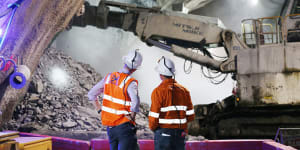Queensland Auditor-General Brendan Worrall warned that rail patronage projections outlined in the most detailed Cross River Rail business case had failed to appear.

Transport Minister Mark Bailey inspects work on Cross River Rail’s underground train station at Roma Street.Supplied
If train usage does not rise,the scales government used to sign off on the state’s largest infrastructure project could flip into negative cost-benefit territory.
While an audit office report released on Thursday noted passenger numbers had started to lift after a COVID-driven drop of 25 per cent in 2020-21,the figures were down even before the pandemic.
The 2016 business case projected daily rail passenger use in south-east Queensland with Cross River Rail would increase by 103 per cent between 2015 and 2026 for an annual average of 6.65 per cent.
But the actual Citytrain network trip data between 2015 and 2019 showed a 6.6 per cent increase,or an annual average of 1.6 per cent.

“There will need to be a significant increase in passenger trips over time for the forecast benefits of the project to be achieved,” the audit office report warned.
Removing traffic from Brisbane roads was another measure of success in the business case,largely “tied to the shift ... from road to rail” and reducing costs linked to congestion and crashes.
Moving more people off roads represented two-thirds of the $3.6 billion total projected benefits. Census data shows driving to work climbed in Brisbane while public transport commutes dropped.
The audit office report noted analysis in the business case suggested the project could slip into a negative cost-benefit ratio if both costs increased,and benefits decreased,by 20 per cent.

Any delay to the expected 2025 completion beyond two years might also lift costs above benefits for the kilometres of tunnels and new and upgraded rail infrastructure and stations.
Weather,conflict in Ukraine and the pandemic meant global supply chain issues had led to material delays and increased the project’s costs.
“The[CRR] Delivery Authority has been monitoring these impacts since early 2022 and working with all stakeholders to determine strategies to deal with potential effects on time and cost,” the audit office said.
The authority had pre-ordered some material,boosted workforces,rescheduled work and extended hours as a result.
Project costs remained within budget,but the actual amount spent to June 30 was about $450 million — or 9 per cent — less than expected.
The audit office found no “significant issues” with tender processes for the government contracts.
Delivery authority boss Graeme Newton told the audit office the state’s decision to not shut down worksites as COVID emerged in 2020 was a “key point of difference” to similar projects in and.
In a statement,Transport Minister Mark Bailey said the rail network was “on track for continued growth”.
The Morning Edition newsletter is your guide to the day’s most important and interesting stories,analysis and insights..